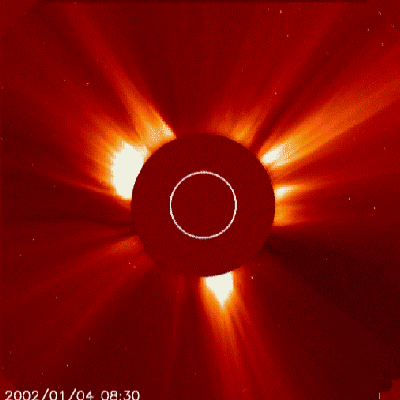SOHO sees dazzling eruption from the Sun
The New Year 2002 got off to a striking start for scientists at SOHO's operations centre who were amazed by a dazzling display from the Sun on 4 January. Beautiful images of an unusually large ejection of solar material were captured by several instruments on the ESA-NASA spacecraft.
In the early hours of 4 January 2002, another spectacular Coronal Mass Ejection (CME) took off from the Sun. The CME, a ball of ionised gas at about one million degrees Celsius hurled from the outer atmosphere of the Sun, began as a filament eruption seen by the Extreme ultraviolet Imaging Telescope (EIT).
As it sped through space at more than 900 kilometres per second, the Large Angle and Spectrometric Coronagraph (LASCO) instrument tracked its progress. The complexity and structure of this CME which was visible as it passed through the LASCO fields of view amazed even experienced solar physicists at the SOHO operations center.
Although the centre of this particular CME was directed almost a full 90 degrees away from the Sun-Earth connection line, it still appeared as a (weak) full halo event, opening up the possibility of a small impact on Earth's space weather. Typically, a CME can often cause fantastic aurorae which are visible a few days after the ejection from the Sun. (It takes a few days for the hot gas to traverse the 150 million kilometres between the Sun and Earth.)
SOHO plays an important role as a space-weather watchdog. It is the only spacecraft which can see these CMEs and can tell if they are directed towards Earth. Satellite operations, radio communications and power grids can all be affected by large CMEs, and advance warning of these events allows preventative measures to be taken.


